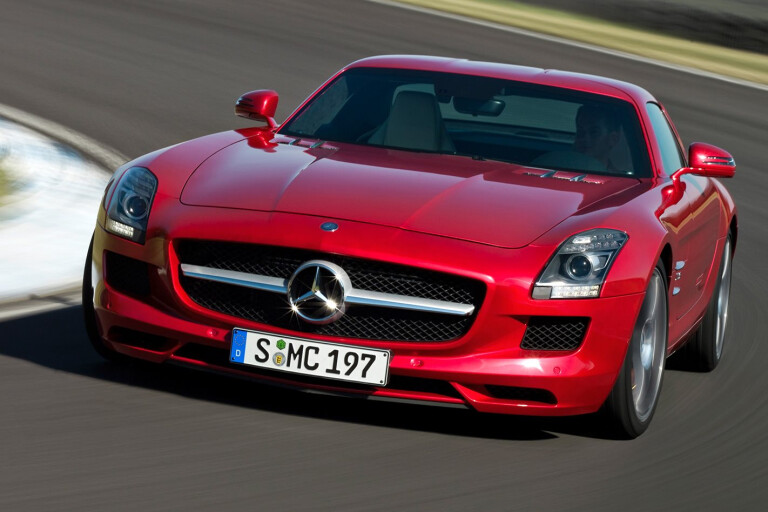
Peering across the vast expanse of aluminium bonnet that dominates the view from inside the Mercedes-Benz SLS AMG, I’m focused intently on the flashing LED brake lights of another Gullwing driven by German touring-car legend Bernd Schneider just in front.
There is a puff of black smoke as he releases pressure on the carbon brakes before darting the matte-black stealth missile to the left and then right … and suddenly, like magic, he disappears from view. Vanished!
Laguna Seca’s famous Corkscrew corner does that. Not in a Bermuda Triangle kind of way, but because the right-left-right sequence of corners drops away like a roller coaster ride. If you’ve ever driven around Bathurst – even at the leisurely 60km/h speed limit – and were amazed by how steep the drop is coming down the Dipper, it has nothing on the Corkscrew. It’s like driving off the roof of your garage.
Just as I flick the SLS I’m in to the right hander with the blind faith that there’s still a road underneath me, Schneider’s car returns to view with the slightest degree of opposite lock as he barrels out of the Corkscrew. Right now, I understand precisely why Mercedes-Benz has chosen this place to unleash the SLS on the world.
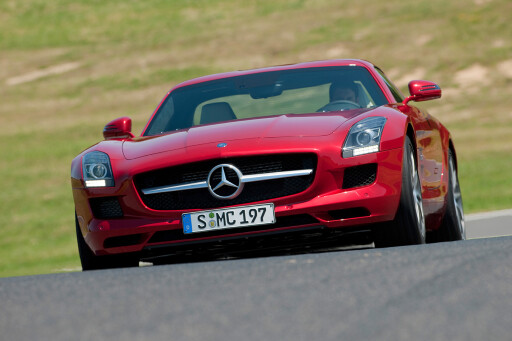 Apart from, perhaps, the cliched Nurburgring Nordschliefe, or maybe even Bathurst itself, Laguna Seca is one of the world’s most demanding race tracks. While the Corkscrew is a serious challenge in itself, the rest of the circuit is a series of super-fast, heart-in-mouth, wide-open corners that offer the ultimate test of handling balance, lateral grip and outright grunt. Perfect sports car territory.
Apart from, perhaps, the cliched Nurburgring Nordschliefe, or maybe even Bathurst itself, Laguna Seca is one of the world’s most demanding race tracks. While the Corkscrew is a serious challenge in itself, the rest of the circuit is a series of super-fast, heart-in-mouth, wide-open corners that offer the ultimate test of handling balance, lateral grip and outright grunt. Perfect sports car territory.
Besides that, it’s located on California’s Monterey Peninsula – a squillionaire’s playground with hilltops and beaches that are saturated by mansions with 10-car garages and roads that are littered with Bentleys, Maseratis, Porsches and big Benzes. Even the nannies drive around here in BMW X5s. Perfect head-turning territory.
And that’s the crux of the Mercedes-Benz SLS AMG; a brilliantly capable sports car that can be thrashed on the most-demanding roads during the day and then driven to the country club in the evening. And it’s super impressive doing both. I know it’s another cliche, but the SLS really does take the ‘liveable supercar’ tag into a new dimension.
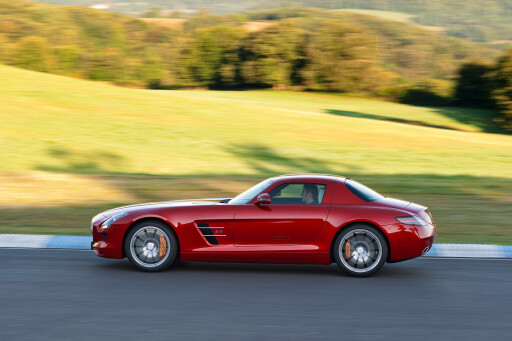
With a price tag somewhere between $450,000 and $500,000 when it arrives here later in 2010, the SLS drops into the Benz portfolio between the brilliant SL63 AMG and the mind-bending, limited-edition SL65 AMG Black Series.
But, more than that, it introduces another everyday supercar into the melting pot, going head-to-head with the likes of the Porsche 911 Turbo, Audi R8 V10 and Aston Martin DBS as well as the no-compromise Italians such as the Lamborghini Gallardo LP560-4 and Ferrari’s 458 Italia and 599 GTB Fiorano.
It’s the first car to be completely designed by Merc’s official performance car partner, AMG – and from a clean sheet of paper. Although it is powered by a unique dry-sumped version of the 6208cc V8 and borrows some hidden electronics and familar switchgear (window switches, columns stalks and air-con controls) from mainstream Mercs, the rest is all new.
There’s no C-class brakes, E-class suspension or S-class seats – the SLS has been designed from the ground up for one purpose.
After its flawed experiment with McLaren and the overweight SLR, Mercedes wanted its new flagship super-sports coupe to be a more pure engineering exercise rather than a technological tour de force. AMG’s primary objectives were to reduce weight, optimise weight distribution and deliver an uncompromised balance between ride, handling and outright performance.
Surprisingly, the SLS is rather simple; there’s no world-first technology and no benchmark bragging rights. It’s not the fastest supercar ever built, it’s not the quickest, it’s not the most powerful and it’s not the lightest. There’s not even tricky electronic dampers, but it is undoubtedly the best car ever to wear the Mercedes-Benz three-pointed star.
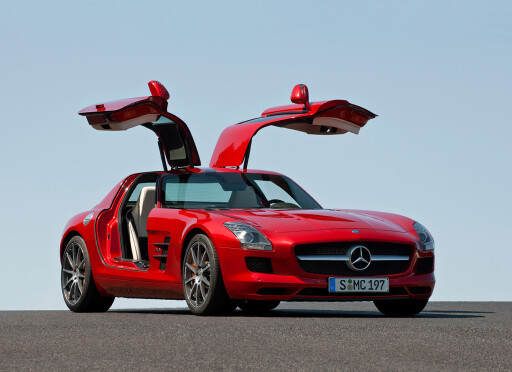
That simplicity was engineered to perfection around an exclusive all-aluminium spaceframe that tips the scales at an impressively lithe 241kg and a total vehicle weight of 1620kg.
Impressive, because when you consider the size of the SLS it’s not a small car. It does look slightly more compact in the metal than it does in photos, but at 4638mm long and 1939mm wide, it’s only slightly smaller than a 1690kg Ferrari 599 GTB Fiorano.
Riding on a 2680mm wheelbase helps push the wheels out as far as possible and frees up plenty of space to mount the 6.2-litre V8 as low and as far back in the engine bay as possible. And it’s a big bloody engine bay. In fact, it totally dominates the car. Considering the SLS is only 1262mm tall (which is around the same as the Audi R8), and the bonnet is almost two metres long, you can’t mistake the SLS for any other supercar.
Maybe a Dodge Viper comes close, but the Benz has a more stylish, sophisticated presence. While I love the car’s proportions, I’m not as convinced by the overall styling of the SLS. The front and rear look as though they were designed by two different teams. There’s more holes in the front-end than a B-grade porno, and they’re clearly there to feed masses of air to the engine bay and brakes.
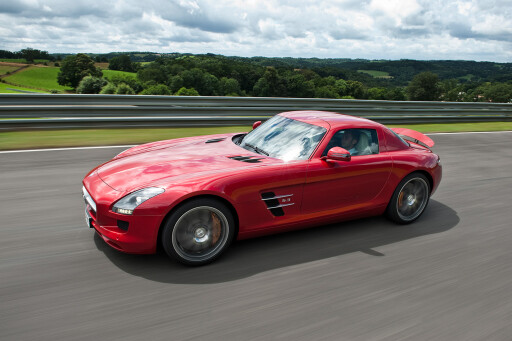 But there’s too much contrast in the rear, as it’s simple design looks like a Lexus or Acura. Sure, you’re never going to see the front and back at the same time, but there just isn’t the same degree of drama at the back as there is front-on.
But there’s too much contrast in the rear, as it’s simple design looks like a Lexus or Acura. Sure, you’re never going to see the front and back at the same time, but there just isn’t the same degree of drama at the back as there is front-on.
But the real theatrics come when you open the unique gullwing doors. Hit the unlock button on the key fob and the handles automatically expose themselve at the lower edge of the door. And although they’re set lower than a conventional handle, only anyone over six foot would have to bend down to grab them.
Lift the handle and the gas struts assist the single-hinged doors up into the air, gracefully and dramatically transforming the SLS into something truly special. However, getting in or out of the two-seater cockpit isn’t nearly as graceful or dramatic.
The paparazzi will be having a field day if any young starlets in short skirts rock up to a red-carpet event in an SLS, as they’ll need to be conscious of protecting their dignity. What seems like the easiest way to drop into the deep-set, heavily-bolstered seat may actually be, let’s say, quite revealing for some.
As you duck your head under the door and drop your bum into the seat, you’ll have to slide your legs over the sill and into the footwell, choreography that has the potential to show the world what you’ve had for breakfast.
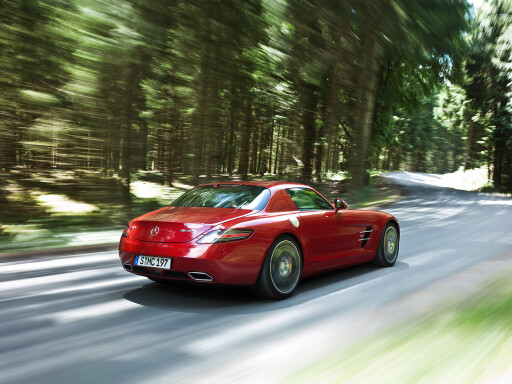
Mercedes engineers, however, spent countless hours perfecting the process and the ‘recommended’ entry procedure is to slip-in feet-first from the back of the door and then slide over the sill into the seat. If you buckle up before closing the door, you’ll struggle to reach for the handle, but grab it on the way down as you slide into the seat and it becomes a simple one-motion exercise.
Getting out is like exiting from a helicopter as you need to duck your head to prevent scalping your noggin on the bottom of the door. None of it seems as convenient as a conventional door system, and it’s slightly out of character for Mercedes to compromise on convenience over style, but the SLS wouldn’t be as special without the doors.
The cockpit is the same; familiar Mercedes but with a subtle twist of exclusivity such as the ridgy-didge aluminium centre tunnel, leather-stitched dash and retro, aircraft-inspired air vents. The seats are set nice and low with a good balance between comfort and support, and the three-spoke steering wheel (with optional Alcantara grips on my test car) is beautifully positioned and perfectly sized for the job at hand.
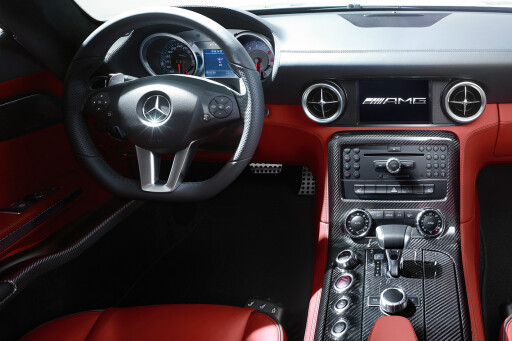
But nothing is as impressive as when you fire the burly V8 into life. The 6208cc all-alloy V8 has been exclusively massaged for the SLS. Based on the top-spec 386kW M156 version that powers the AMG flagship models (E63, S63, CL63 and SL63), the SLS’s M159 V8 features a number of key changes that lift its power to 420kW (at the same 6800rpm peak) and maximum torque to 650Nm, produced lower down the rev range (4750rpm) compared to the 630Nm developed at 5200rpm in standard tune.
AMG claims that more than 120 individual components have been redesigned for the SLS, including a magnesium intake manifold with eight precisely tuned runners, forged lightweight pistons, a reinforced crankshaft bearing and a stronger crankcase. And, of course, the switch from a conventional sump to a dry-sump lubrication system to improve the engine’s location required numerous mods to the oil delivery and valvetrain tuning.
The exhaust has also been specifically tuned for the SLS, which is instantly apparent when it fires up. While it’s relatively quiet at low engine speeds and emits a subtle and classic big-bore V8 burble, if you kick the accelerator into the floor at cruising pace, the surge of torque is matched only by a rising crescendo of noise.
It wails through the mid-range into a bellowing cacophony at the top-end that is devilishly addictive and should be recorded for future generations. Step out of it and the crackle on the overrun is just as delicious – at any engine speed – and somehow even louder and sweeter than it is in the SL63 and E63. It’s acceleration is phenomonal too.
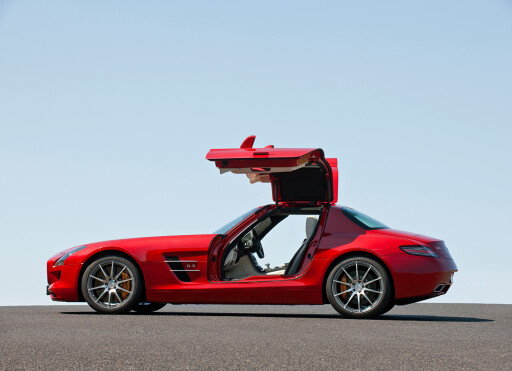 With rear-biased 47/53 front/rear weight distribution thanks to a rear-mounted transaxle, the SLS hunkers down on its haunches and bolts to 100km/h in a claimed 3.8sec before it runs into an electronically limited wall at 317km/h.
With rear-biased 47/53 front/rear weight distribution thanks to a rear-mounted transaxle, the SLS hunkers down on its haunches and bolts to 100km/h in a claimed 3.8sec before it runs into an electronically limited wall at 317km/h.
The weight distribution and low centre of gravity also play into the SLS’s handling. With a race-derived double-wishbone set-up on all four corners and conventional hydraulic power steering assistance, the SLS is beatifully balanced at any speed.
The steering is pin sharp with instant feedback and crisp off-centre feel, and it takes a while to get used to the intimidating pendulum effect that even the smallest input makes, simply because you sit so far back from the front wheels and the relatively stiff spring rates eliminate almost all body roll. But once you’re used to it, the SLS shrinks around you and can be pitched into any corner, fast or slow, with loads of confidence.
There’s no drastic weight transfers – either pitching it into understeer during hard braking like a traditional front-engined GT, or the lift-off oversteer of a mid-engined supercar. It just sits flat, grips and bolts to the next bend.

On the track at Laguna Seca, its handling is almost flawless with only the slightest hint of understeer through the fastest sweepers and easily tamed oversteer on the exit of the slow stuff. It’s brilliant handling isn’t just one dimensional either.
On back-country roads between San Francisco and Monterey, it’s just as sweet and well balanced, maintaining a degree of poise that makes it the easiest front-engined supercar to punt quickly. And when you’re not, its delicate damping makes it surprisingly comfortable to cruise around town at a leisurely pace.
Although it has yet to be officially tested around the Nurburgring, AMG test engineers have already lapped the circuit in under 7:40sec – which puts it in the same league as the Porsche 911 Turbo, but more importantly shoots it to the top of Benz’s timesheets as it’s almost 10 seconds quicker the McLaren SLR it replaces.

If there’s one mechanical gripe, it’s that the seven-speed dual-clutch (the same Getrag unit that debuted in the Ferrari California) doesn’t seem to be as sweet or as intuitive as the Speedshift MCT auto in the SL63 and E63. Its base Comfort setting is soft and gentle, but it can get caught out creeping away from traffic lights and shunts between first and second gears under light-throttle getaways.
Although Merc engineers claim the DCT shifts quicker than the MCT in manual mode, it does so without the dramatic crack and pop from the ignition cut that makes the auto so inviting to drive hard.
But, if that’s all there is to complain about then that’s saying something. Unlike the SLR, which was overpriced, overweight and overstyled, the SLS is damn near perfect. It’s so much more than a retro recreation of a past legend. It’s a modern classic of its own accord.

COMMENTS